Samsung's Galaxy S 4: Introduction & Hands On
by Anand Lal Shimpi on March 14, 2013 7:30 PM EST- Posted in
- Smartphones
- Samsung
- Mobile
- Galaxy S 4

Since 2010 Samsung has grown to become not only the clear leader in the Android smartphone space, but the largest smartphone manufacturer in the world. Its annual iteration of the Galaxy S platform is now arguably one of the most widely anticipated smartphone launches each year.
Like clockwork, tonight Samsung announced the Galaxy S 4: a 5-inch 1080p smartphone, and the new flagship for the Galaxy brand. We just finished learning about the device and spent a short time playing around with it.
Most of the hardware specs are known quantities. The 5-inch Super AMOLED display features a 1080p resolution, for a pixel density of over 441 ppi. The chassis is plastic with a metallic looking rim around the edge. Like most Samsung devices, the Galaxy S 4 feels well built although the plastic construction makes it the polar opposite of HTC's One - and truthfully in a different league altogether. I don't personally believe Samsung's use of plastics is terrible, but it definitely doesn't lend itself to the same sort of remarkable designs we see from HTC or Apple. On the plus side the SGS4 feels very light (it's even lighter than the SGS3). The tradeoff between material feel and weight is one that has a spectrum of solutions. Samsung remains on prioritizing weight and cost, which is understandable given the success the company has seen thus far.
The SGS4 feels surprisingly comfortable in hand, partly due to weight and party due to the device's proportions. I didn't mind the size at all.
The Galaxy S 4 is available in two colors: white frost and black mist. I played with an international SGS4 variant in white frost.
| Smartphone Spec Comparison | ||||||
| Apple iPhone 5 | HTC One | Samsung Galaxy S 3 | Samsung Galaxy S 4 | |||
| SoC | Apple A6 1.3GHz | Snapdragon 600 1.7GHz | Snapdragon S4 1.5GHz | Exynos 5 Octa (1.6/1.2GHz) or Snapdragon 600 1.9GHz | ||
| DRAM/NAND/Expansion | 1GB LPDDR2, 16/32/64GB NAND | 2GB LPDDR2, 32/64GB NAND | 2GB LPDDR2, 16/32GB NAND, microSD | 2GB LPDDR3, 16/32/64GB NAND, microSD | ||
| Display | 4.0-inch 1136 x 640 LCD | 4.7-inch SLCD3 1080p, 468 ppi | 4.8-inch Super AMOLED 720p, 306 ppi | 5-inch Super AMOLED 1080p, 441 ppi | ||
| Network | 2G / 3G / 4G LTE Cat 3 | 2G / 3G / 4G LTE Cat 3 | 2G / 3G / 4G LTE Cat 3 | 2G / 3G / 4G LTE Cat 3 (depending on region) | ||
| Dimensions | 123.8mm x 58.6mm x 7.6mm | 137.4mm x 68.2mm x 4mm - 9.3mm | 136.6mm x 70.6mm 8.6mm | 136.6mm x 69.8mm x 7.9mm | ||
| Weight | 112g | 143g | 133g | 130g | ||
| Rear Camera | 8MP | 4MP w/ 2µm pixels | 8MP | 13MP | ||
| Front Camera | 1.2MP | 2.1MP | 1.9MP | 2MP | ||
| Battery | Internal 5.45 Wh | Internal 8.74 Wh | Removable 7.98 Wh | Removable 9.88 Wh | ||
| OS | iOS 6.1.2 | Android 4.1.2 | Android 4.1.2 | Android 4.2.2 | ||
| Connectivity | 802.11a/b/g/n, BT 4.0, USB 2.0, GPS/GNSS | 802.11ac/a/b/g/n + BT 4.0, USB2.0, GPS/GNSS, MHL, DLNA, NFC | 802.11a/b/g/n, BT 4.0, USB 2.0, NFC, GPS/GNSS, MHL | 802.11a/b/g/n/ac (HT80) + BT 4.0, USB 2.0 NFC, GPS/GNSS, IR LED, MHL 2.0 | ||
The back cover remains removable, as does the 9.88Wh battery:
Internally, there’s 2GB of memory and 16 - 64GB of on-board NAND, with a microSD card slot for optional storage expansion.
As expected, the SoC will vary depending on region. Samsung will offer either its own Exynos 5 Octa or a 1.9GHz quad-core Snapdragon SoC from Qualcomm. Given the clock speed and the timing, I would assume Samsung is talking about a Snapdragon 600 but the only official word from Samsung is the 1.9GHz quad-core Snapdragon. Update: Qualcomm has confirmed that this is a Snapdragon 600.
The Exynos 5 Octa side is a bit more interesting. Samsung is calling the SoC a 1.6GHz Octa-core part, but that appears to be the clock speed for the four Cortex A7 cores. The four Cortex A15 cores will run at up to 1.2GHz, which should help keep power consumption manageable. We’ve been wondering for a while what clock speeds we’d see the Cortex A15s run at in smartphones, and I believe this is the first line drawn in the sand. If we go back to Samsung’s ISSCC disclosure of Exynos 5 Octa power consumption, it looks like peak CPU power consumption should be somewhere around 2W - definitely better than what we saw from Exynos 5 Dual in the Nexus 10. Again, no surprises here given that we’re talking about a smartphone - it’s just interesting to see. Update: There seems to be some confusion as to whether or not the A7/A15 clocks are 1.6/1.2 or 1.2/1.6. I was told the former and that's what I wrote down, but it's entirely possible that the information given wasn't correct. I'm awaiting for further confirmation. Although 1.2GHz makes sense for a max clock for the A15s, 1.6GHz is a bit high for A7s if they're truly to be used to keep power consumption down. I can see it working either way.
Samsung isn’t ready to talk specifics about what SoCs will end up in what regions. We weren’t allowed to run any downloaded applications or benchmarks on the hardware at the event, nor were we told what SoCs were used in the demo hardware. Both SoCs should be good choices though.
Similarly, there’s no disclosure on what baseband silicon is being used although LTE support will be offered depending on the region. It’s highly likely that we’re looking at another MDM9x15 with a discrete applications processor (Snapdragon or Exynos 5 Octa). All of the expected wireless connectivity options are present including 802.11ac and BT 4.0. Samsung is claiming support global LTE roaming (up to six different bands) and FDD/TDD LTE.
As is the norm these days the Galaxy S 4 comes with both a front and rear facing camera. The front facing camera features a 2MP sensor and is capable of recording video at 1080p30. The rear facing camera sees a move to a 13MP sensor with flash. No word on the max aperture or focal length of the camera systems at this point.
The Galaxy S 4 will ship with Android 4.2.2. It will be available both internationally and in the US starting sometime in Q2 (Update: first shipments will be in April). US operators signed up to carry the Galaxy S 4 are AT&T, T-Mobile, Sprint, Verizon, Cricket and US Cellular.


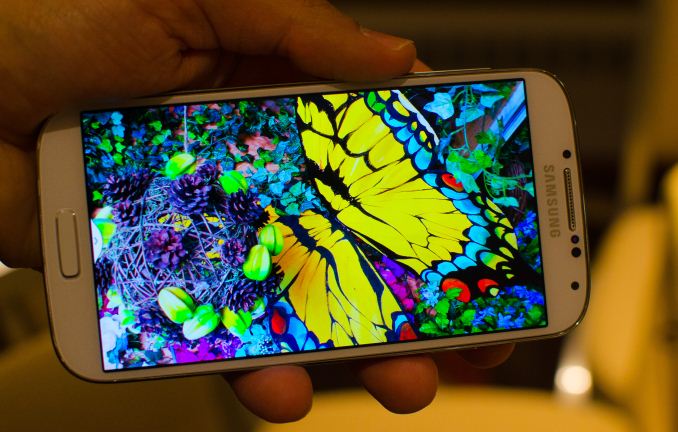
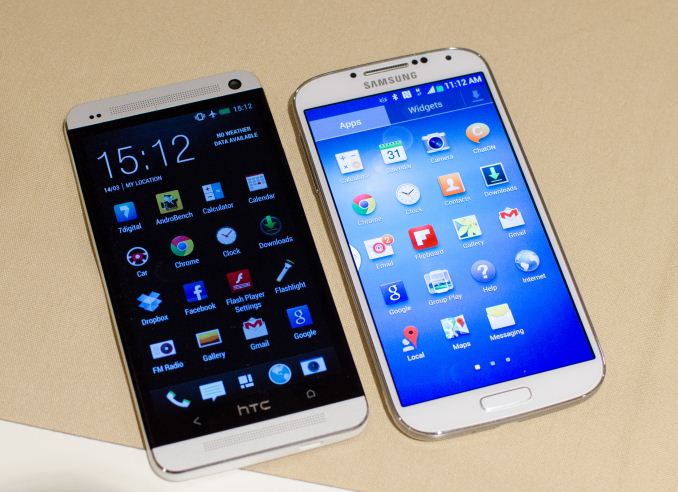

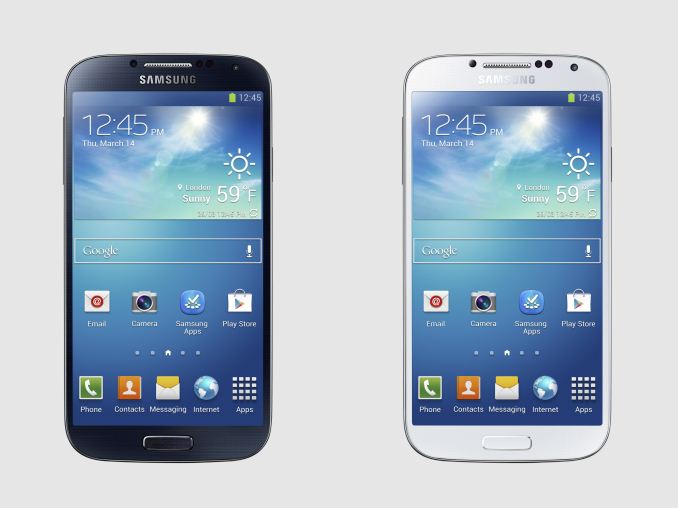
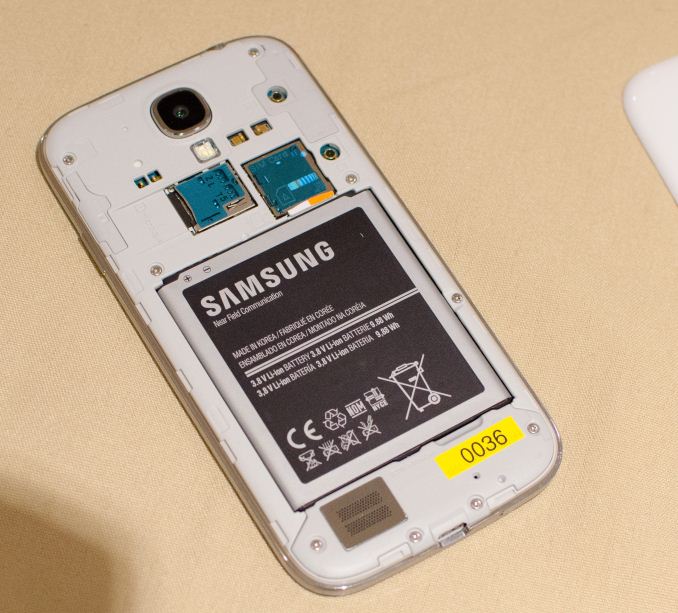
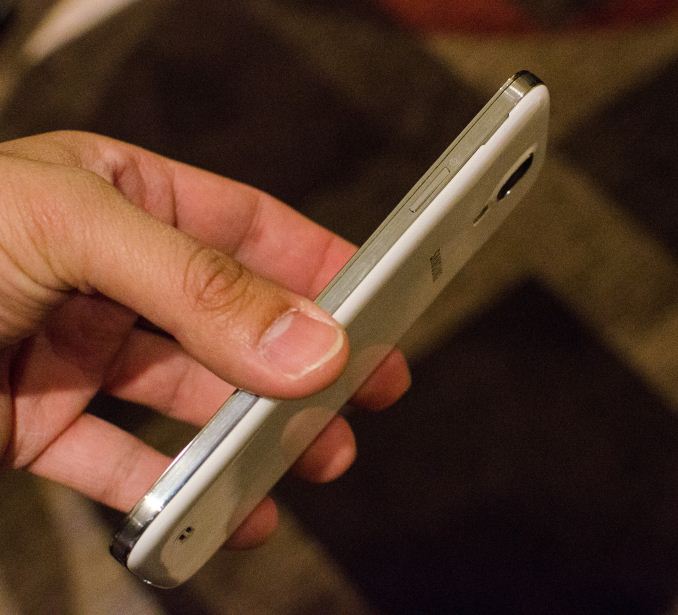















206 Comments
View All Comments
OCedHrt - Monday, March 18, 2013 - link
Since HTC is still failing at marketing, I'd like to point out that it also has IR sender for remote control.ATBTCT - Tuesday, March 19, 2013 - link
What the heck are you spouting? Samsung puts bigger battery compared to other manufacturers and still manages to make it removable. You are saying as if phones with non-removable battery have bigger battery, which is exactly the opposite save for razr maxx. Just look at HTC one x and HTC ONE. What did HTC gain by making the battery non-removable and what did Samsung lose by making it removable? Nothing. Whether the phone has bigger battery or not has nothing to do with it being removable or not....no matter what the companies say...Having removable battery just gives you choice. For me removable battery doesn't mean I go on swap frenzy but I can swap it when necessary. In any case Samsung phones have good battery life compare to likes of many who use non-removable batteries except for web browsing where having AMOLED screens has its disadvantages.ATBTCT - Tuesday, March 19, 2013 - link
Yes, a keyboard Geek who is apparently a fool knows a lot about a phone that he has never seen. Maybe you should go and give Samsung engineers a lesson on how you should give up on something when you run into an obstacle.shorty lickens - Thursday, March 21, 2013 - link
Will all these neat features be added to the Note 2? Cuz I really dont wanna swap phones after three months.boe - Thursday, March 21, 2013 - link
All I want to know is did Samsung finally work with Verizon to fix their POS radio/reception/antenna issues?I love the PDA side of the Samsung phones but their phones don't work for crap on Verizon's network. The HTC and Motorola phones work fine so it isn't Verizon's network, it is just that Samsung can't be bothered to fix their f'n phones.
They fooled me once with the Galaxy Nexus - shame on them. They fooled me twice with the S3 - shame on me. NOT until they fix the reception issues will I ever get a Samsung phone again or until I switch carriers.
ANKSHA - Thursday, March 21, 2013 - link
Does S4 support both technology GSM and CDMA? Suppose if I buy S4 from VERIZON/SPRINT.... can I switch back to AT&T/TMOBILE?brandensilva - Monday, March 25, 2013 - link
I'm fine without the spare battery swapping annoyances. I did happen to purchase a fairly large battery pack though that I can use if I really need the juice on trips. I could easily have my phone go a full week of heavy usage with it. I find that far more convenient than actually shutting the phone off and throwing in a new battery.superflex - Monday, March 25, 2013 - link
Could the display be any more over saturated?yos123 - Tuesday, March 26, 2013 - link
I like the way everything is detailed. Great postrohini - Friday, March 29, 2013 - link
i agree that it is a very decent phone and Samsung is trying to keep a check on the price tag of its smartphones but WE CAN'T JUST IGNORE the looks of the phone. In India its going to cost us about 45k INR which is a huge amount of money and the buyer wouldn't mind if it made to look somewhat better than the SGS3.Why the hell does it have its looks identical to the older SGS3??
On the other hand, the phone comes with a lot of software goodies like air gesture and something called eraser shot. More info can be found on http://www.speedmango.com/15-awesome-features-of-s...
What I believe is that these days the hardware spec war is coming to an end. People dont care that much the hardware specs anymore. Even a 15k Micromax Canvas HD has a quad-core processor. What matters the most is the software features and the after sales support.